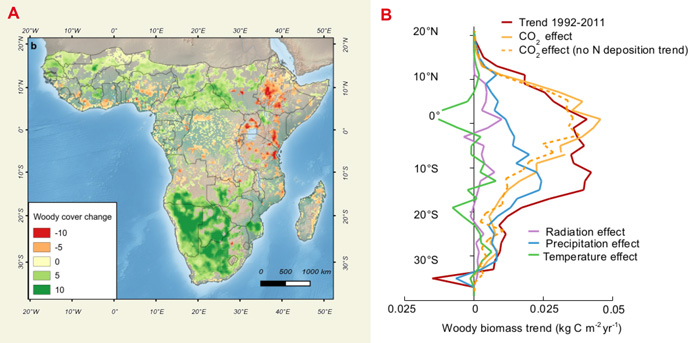| Tweet | Follow @co2science |
Paper Reviewed
Brandt, M., Rasmussen, K., Pe˝uelas, J., Tian, F., Schurgers, G., Verger, A., Mertz, O., Palmer, J.R.B. and Fensholt, R. 2017. Human population growth offsets climate-driven increase in woody vegetation in sub-Saharan Africa. Nature Ecology & Evolution 1: 0081, DOI: 10.1038/s41559-017-0081.
According to Brandt et al. (2017), "little quantitative information is available about the state, rate and drivers of change in the cover of woody vegetation at the scale of the African continent." And so it was that this team of nine researchers set out to fill this data void.
To accomplish their objective, Brandt et al. used "a new passive microwave Earth observation (EO) data set (vegetation optical depth, VOD) that captures continuous changes in the coverage of canopies of all woody phanerophytes, regardless of size, in both drylands and humid areas," to calculate changes in annual woody cover in Africa (from 20°N to 30°S) over the period 1992-2011, as well as the causes of those changes.
As shown in the figure below (Panel A), the change in woody cover was predominately positive (36 percent of the land area experienced an increase while 11 percent showed a decrease, with an overall area increase of 2.1% over the two-decade period of analysis). With respect to the factors responsible for these changes, Brandt et al. report that "agricultural expansion, urbanization and wood fuel harvest were the main causes [of] decrease," whereas the aerial fertilization effect of the air's increasing atmospheric CO2 concentration and changes in precipitation were largely responsible for driving the areas of increase (see Figure 1, Panel B).
The above findings correspond well with reports from elsewhere in Africa and all across the globe that demonstrate rising CO2 concentrations are enhancing the vegetative productivity of the biosphere and causing a great greening of the planet (see the many examples archived in our Subject Index under the heading Greening of the Earth on this page), except for those locations where human land use and land cover changes dominate.

Figure 1. Panel A: Percent absolute change in woody cover estimated from satellite observations for the period 1992-2011. Panel B: The total trends of woody biomass in sub-Saharan Africa, from north to south, along with the estimated contribution to this trend from the relative effects of CO2, precipitation, radiation, and temperature. Source: Brandt et al. (2017, supplementary information).




